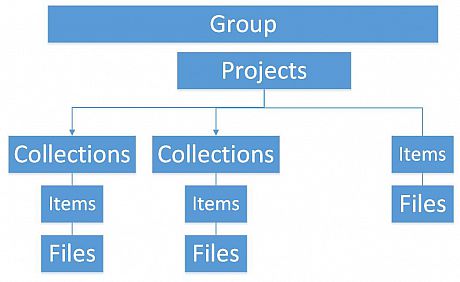Organise your data
At the end of your research project you may have a large amount of data that you have organised into folders.
Figshare has the potential for accommodating 5 levels of folder organisation. These levels act in a much different way to nested folders in your file manager. Figshare names these levels as follows:
A Group page is like a website home page for your data. It can contain all your Projects, Collections and Items. You can write a description for all the data and have your own banner and logo. Groups can't have DOIs. Groups are only generally used for Schools, Departments, Labs, Research Centres and large research projects. You can't create a Group yourself. You need to make a request to the Research Data team in the Library who can create a group for you after discussing your needs and to add your desired banner and logo. Click here for more information on Group web pages.
Projects can contain Items only. You can write a description that explains what all the Items are and how they relate to each other. This description can contain an explanation of what your project is about as a whole. You can't nest Collections within Projects, but you can imply a hierarchy by inserting links to them with DOI URLs. Your description could also encompass all of the data held in those Collections. Projects can't have DOIs. See this guide to find out how to create a Project.
Like Projects, Collections can contain Items only. You can write a description that explains what all the Items are and how they relate to each other. This description can contain an explanation of what your Collection is about as a whole. If you have created other related Collections, you can enter the DOI of each of these Collections to link out to them. You could also add a URL link to any related Project. Every Collection can have a DOI. See this guide to find out how to create a Collection.
Items can contain one or many Files, or no Files at all. Items are the lowest level of description where the most detailed metadata about your data is kept. Every Item can have a DOI. Items can exist in a Project, Collection or Group or all of these at the same time!
Files can only exist as part of an Item. You can upload as many files to an Item as you like. If you want to describe an individual file and have separate metadata for it, then it has to be the only file in an item. If you want to describe a set of files then they can be in the same Item and you can use the Item metadata fields to describe them all.
You can have any combination of these. So you could have Items that exist in a Group without Projects or Collections, or you could have Files and Items that exist in both Projects and/or Collections but not in a Group. An example model might look like this:

It's really up to you and depends on your data as to what the best way to use the levels is. You may decide that a Collection is sufficient for the highest level. If you don’t have a Group then all your Items/Projects/Collections will appear in your school Group by default.
Instructions for organising your data
You first need to upload all of your files to Figshare; see this guide for information on uploading your data. If you decide to use a Project or multiple projects, you can move items to these projects after creating them by selecting the relevant items in my data and clicking ‘Actions>Move to/from project’ in the drop down menu just above the item list. You can also create new Items directly from within a project.
You first need to upload all of your files to Figshare, see this guide for information on uploading your data. If you decide to use a Collection or multiple collections then you can put items in each Collection after you have created it. Simply click ‘Add from My data’ from within each Collection and select the items you want.
You can link to other collections from any Collection or Project by putting their DOIs into the ‘Related Collection’ field. Make sure you put the https://doi.org/ part in front of the DOI.
If you have a Group page then you will need to make sure that any projects and collections that you use appear in that group as follows:
- Projects – when you create a project ensure you select ‘group’ under the Project Type section and then select the name of your group. The Project and any items in it will then appear in your group page. Make sure you do this when creating the project – you can’t do it after.
- Collections – when you create the collection, under the ‘Groups’ section select the name of your group. The collection and any items in it will then appear in your group page.
This is all a bit easier to show than explain. If you want any help organising your data on Figshare then email research-data@sussex.ac.uk to arrange a session with a member of the Research Data Team in the Library.

